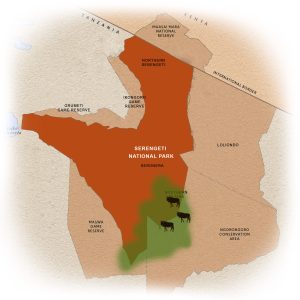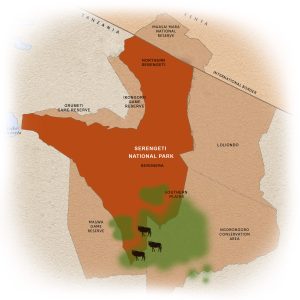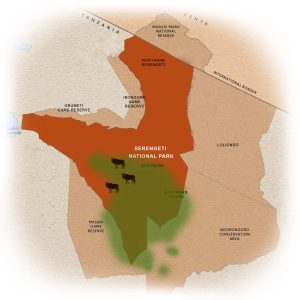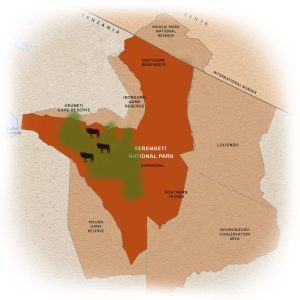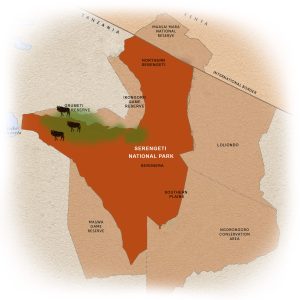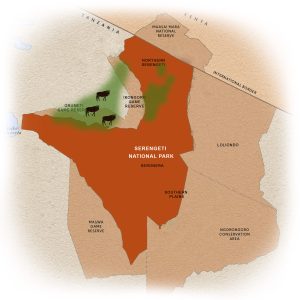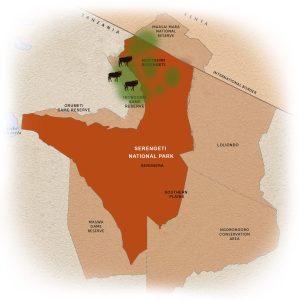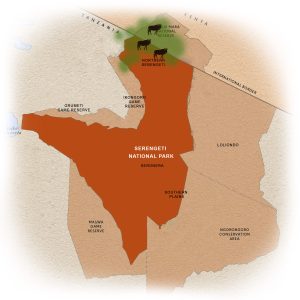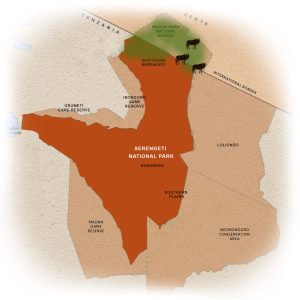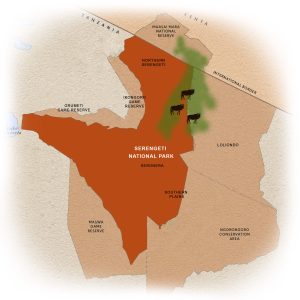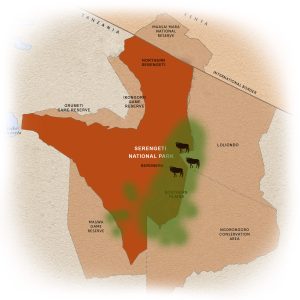The Great Wildebeest Migration that takes place in Serengeti in Tanzania and Masai Mara in Kenya is one of the greatest mass terrestrial wildlife movements that exists in planet earth. It is the driving force behind travellers venture to Kenya and Tanzania for a Migration safari, especially around the month of june.
Termed as one of nature’s greatest paradoxes, knowing the wildebeest migration timing is absolutely vital, but the challange is the predictability of the animals’ movements. It is obvious that the wildebeests, together with zebras and antelopes will cross the Mara River – but nobody knows exactly when. We also know that rain will trigger their migration in search of fresh grazing grounds – but nobody knows exactly when the rainfall will commence.
With our assistance as professional and experienced as Wildebeest Migration safaris experts, We will help you just like we have done the same to thousands of travellers to be in the best possible place at the best possible time at the best possible price, to enable you get exactly what you have been looking for in this wonder of the world.
Predicting The Migration River Crossings:
This has been such a hard nut to crack!, not even the wildebeests, the zebras or the antelopes know when they’re going to cross the river! Its so instinctive, that Some arrive at the river bank and swim over immediately, some arrive and spend days hanging around grazing and some arrive and turn back to where they came from. So its not very possible to come up with the exact crossing river crossing time. Its adviseable to have as much time on safari as possible if you hope to see a river crossing.
In Which Month Does Wildebeest Migration ?
Most people think that the Wildebeest Migration only takes place between July and October, but it’s actually an ever-moving, circular migration with various but equally exciting events that occur year-round. The popular river crossings usually coincide with safari’s high season (June to October), hence the perception that this is the only time of the year that the wildebeests are on the move or can be viewed.
Where Does The Great Migration Start?
Because the Great Migration is an instinct- driven, year-round movement of more than two million animals across the Serengeti-Mara ecosystem, there are no defined start or end points. The Gnu Migration is triggered by East Africa’s rains and the animals follow an age-old route in search of fresh pasture and water. This epic journey takes the wildebeests across the Masai Mara plains in Kenya, all the way south into Tanzania’s Serengeti upto the edge of the Ngorongoro Crater, before circling up and around in a clockwise direction to their original grazing starting point, where they find fresh pastures waiting for them to start over again.
This Great Migration is dictated primarily by the wildebeest’s response to the weather, moving after the rains and the growth of new grass, essentially following a natural instinct to find food to stay alive.
GENERAL MIGRATION PATTERN:
The East African weather is nolonger as predictable as it used to be some years ago due to climate change. The raisn can come early or late depending on how nature has dictated the rains to fall and the pastures to grow for the gnue to start migrating. Below is a general guideline for where the herds are during the year.
January
The herds are in Tanzania, grazing in Serengeti National Park, and move south from the north-east region and into the area near Lake Ndutu. The Serengeti national park is not fenced, so the herds are free to move where they can find grazing pastures. Remember that although up to two million wildebeests, zebras and antelopes form the Serengeti Migration, they are not all in a single herd. The animals break up into mega-herds of thousands or hundreds of individuals at time but move towards a common destiny.
February To March
This is the calving season with over 8 000 wildebeest newborns are introduced each day! The old and sick wildebeest, antelope and zebra family members included in the migrating herd creates lots of feasts for predators and heartbreak for the migrating parents. The Serengeti’s big cats take the lion’s share, but hit-and-run jackals, packs of wild dog, and hyena clans add to the spectacle. It’s survival for the fittest.
April
It’s the start of the long rains (Apr–May) and the herds generally move in a north-westerly direction towards the Moru and Simba Kopjes. The action-packed rutting (breeding) season is in full swing, featuring testosterone-fuelled jousts between males competing for the right to mate with receptive females.
May
Wagons roll! The massed herds are on the go, huge columns of up to 40 kilometres (25 miles) in length can sometimes be seen as the wildebeest funnel up into the central Serengeti. Everyone’s moving a little quicker now that the calves are stronger.
June
The wildebeest are usually in the central Serengeti and getting ready for the toughest part of their journey. The herds may have split up, with some already crossing the Grumeti River.
July
The Great Migration have reached the Grumeti region and northern parts of the Serengeti and are peering closely at the treacherous waters of the Mara River they have to cross into Kenya. Why? Huge Nile crocodiles, that’s why!
As mentioned, it is impossible to accurately predict river crossings – they depend entirely on the rains and the often unpredictable wildebeest themselves. It’s vital to book your Wildebeest Migration safari in Africa up to a year in advance to get a lodge on or as close to the river as possible – this cuts down on travel time to lookout points. The wildebeest do have historical crossing areas and you may spend days staked out in the hope of seeing the action. We recommend choosing a mobile safari camp that moves with the Migration to ensure you’re in the right place at the right time to get the best experience.
August
August is generally considered the best time to witness the dramatic river crossings from the northern Serengeti into the Masai Mara. You’ll need a passport to cross into Kenya; the wildebeest are exempt. The Masai Mara National Reserve is open to members of the public so for a more exclusive safari experience, head for the private conservancies that are contiguous with the reserve.
September
The herds break up into smaller groups, as not all the wildebeest migrate into Kenya. The permanent group wich is always less than half of the animals remain in the northern Serengeti, the rest are swapping war stories in the Masai Mara. So you could still see wildebeests in the Serengeti. Infact generally, Masai Mara is the best place to witness the Migration in September.
October
Your best bet is still the Masai Mara, but bear in mind it is a far smaller reserve than the Serengeti and there may be a lot of other visitors. The neighbouring private conservancies are much less crowded and, not only will you still be able to witness the Migration, you will also directly contribute to the Maasai communities who have lived there for thousands of years. Plus you can enjoy off-road game viewing, night drives and walking safaris – activities not permitted in the national reserve.
November
Normally, the short rains have begun, propelling the wildebeests to leave the now denuded grasslands of the Masai Mara and head back into the rejuvenated Serengeti plains. Bear in mind that the rains can be late or early, which is also unpredictable.
The herds are generally on the move, but can be seen around the north-eastern parts of the Serengeti where they may split into smaller groups for their journey heading south.
Tip:
Africa is believed to be a hot place but the rains can cool things down dramatically. When you go for an early morning or late evening game-viewing, the sun is at its weakest, remember to take at least one pair of trousers, closed shoes that can cope with mud, and a fleece or waterproof jacket for comfort.
December
Fresh grazing grounds see the wildebeests move south, covering the northern and eastern Serengeti to feast and prepare for yet another death-defying, 3 000-km epic journey.
The Best Time To Go On A Migration Safari
Depending on which events you are interested in seeing during the mass migration, you can choose the best time for you to go on this trip trip now that you have a clue. But the Serengeti and Masai Mara’s abundance of wildlife and wide open landscapes make them fantastic year-round safari destinations.
Event Approximate Time Place
Calving (Birthing) Season -February to March – Southern Serengeti
Rutting (Breeding) Season -April to May -Western & Central Serengeti
Grumeti River Crossings -May to June -Central Serengeti
Mara River Crossings -July to August -North Serengeti & Masai Mara
On the Move -November to January -Mara,North,South Serengeti
Note: the above are approximate dates only. The Wildebeest Migration is a year-round, circular phenomenon and the river crossings cannot be predicted. Sometimes the herds stay put for two weeks, other times they could cross three or four times in one day!
Points To Remember Aboout Migration
The bulk of the Migration takes place in Serengeti National Park in Tanzania.
It’s a year-round, circular journey that occurs instinctively.
River crossings cannot be predicted, but generally occur between May and August annually.
The animals are strung out across a large area, composwd of fore-runners and stugglers.
The best chance of seeing river crossing may involve spending all day at a site where the wildebeests have crowded. This occurs mostly around midday when the sun and glare are at their harshest, so .you should be prepared for this.
Best Places To Stay During A Migration Safari
Accommodation for a Great Migration safari can be divided into two broad categories: permanent lodges and mobile camps. Each have different advantages, but choosing one depends on what you can afford or looking for:
Mobile Camps Permanent Lodges
Bathrooms -En suite tents with flush toilets
Usually bucket showers – En suite with hot-and-cold running water
Basins may use jug water -Plumbed showers
There may not be running water -Flush toilets
Maybe outdoor showers
Wi-Fi
Not always – Usually
Power / Electricity
Solar,communal charging point -Generator, Solar, In-room Chargin
Tips for Choosing Migration Safari Accommodation In Serengeti and Masai Mara
Once you have decided to go on a this trip, Book as soon as you know you can. Lodges and campsites are small and fill up very fast.
The river-crossing season is the most popular season, so start planning at least a year in advance for you to get a chance.
If you want inter-connecting tents or family suites, book as early as possible as there are limited numbers of these available.
If you’re travelling with very young children, consider fenced accommodation type, babysitting services and your own private game-drive vehicle.
If you have mobility challenges, ask for rooms as close to the mess areas as possible to avoid long walks, often on soft sand.
If you are on a budget, choose good-value accommodation as early as possible so that you have extra time on safari. This increases your chances of seeing crossings, births and kills.
TIPS FOR BOOKING THE MIGRATION SAFARI
1. Book Early – At Least a Year in Advance
Lodges and camps fill up fast, especially for a Great Migration safari from June to October. Remember, this is safari’s high season and when the popular river crossings happen, but you can see the herds any time of the year.
2. Arrange Your Timing Carefully
The Migration is a fluid, often unpredictable affair. It’s important to know where to go and when to go on a Wildebeest Migration safari to ensure your expectations are met. Choose and arrange your timing according to what you want to see and experience.
3. Diversify Your Game Viewing
A Wildebeest Migration experience can at times get busy, smelly, and far removed from the general Big 5 safari. We highly recommend ending at a lodge or campsite that’s located away from the noisy herds to enjoy a bit of tranquility and a diverse game viewing experience.
4. Add More Value to Your Migration Safari
The Masai Mara and Serengeti combine easily with each other, and each can also form the focal point of a larger safari itinerary. We recommend combining the Masai Mara with Amboseli and Laikipia, or adding the Ngorongoro Crater, Tarangire and the Rift Valley Lakes to the Serengeti. This will give you great chances of experiencing the unique wild game and a wide range of bird species that inhabit the rift valley salty lakes.
